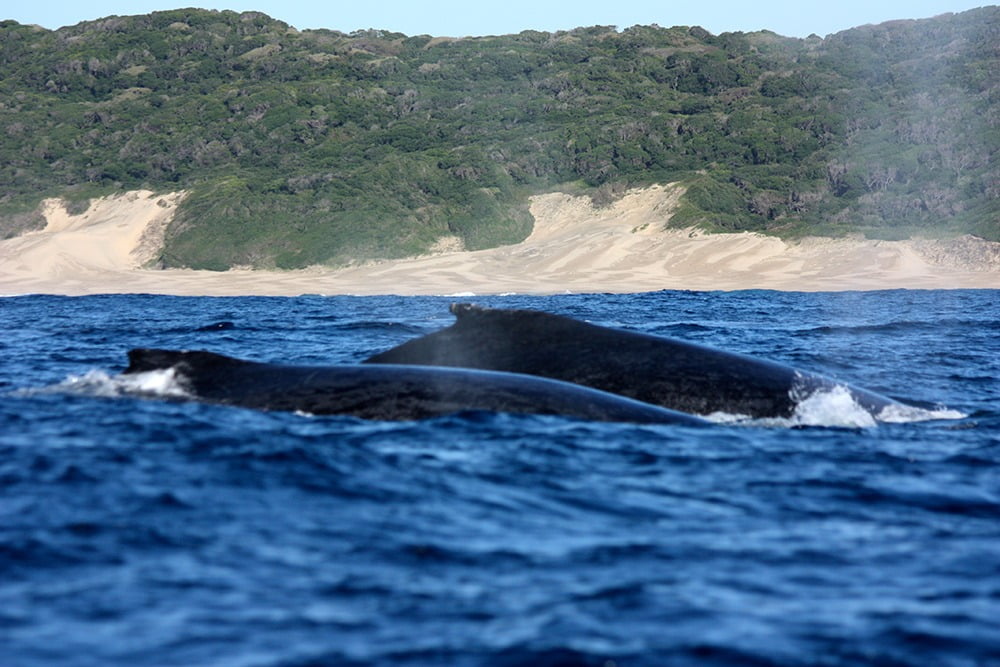ORDER: CETACEA
FAMILY: BALAENOPTERIDAE
CLASS: MAMMALIA
GENUS: MEGAPTERA:
LENGTH & WEIGHT: Males 15 – 16m and up to 36 tonnes; females 16 – 17m and up to 44 tonnes.
LONGEVITY: Estimated between 50 and 60 years.
DIET: Krill and a variety of schooling fish.
SEXUAL MATURITY: Between 5 and 7 years.
GESTATION: Approximately 11.5 months.
CALF SIZE: 6.1m in length, weight 2 tonnes.
LACTATION: Calves suckle for at least 6 months with up to 1 year of mixed nurturing.
Humpback whales are found in all oceans around the world. Once almost an extinct species due to the whaling industry, their numbers have since increased to around 80 000, after the moratorium was introduced in 1966.
Humpback whales are migratory and can travel up to 25 000km per year. They spend their summers in polar waters where they feed, and then in winter migrate toward the equator where warm tropical waters become their breeding grounds.
Humpback whales have large stocky bodies and are most easily identified by the hump on their backs that appear to be part of the leading edge of their dorsal fin. The head and lower jaw are covered in knobs called tubercles which are actually hair follicles, characteristic of the species.
Their tail fin is almost a third of their body length and they have unique patterns on them, enabling individual identification between whales. The pectoral fins are the longest of any cetacean, which, due to their large surface area, are believed to accommodate for temperature control between cold and warm waters, as well as for higher maneuverability.
Humpback whales are solitary animals, giving them a typically “loose-knit” social structure. Groups may stay together for a short period during summer, possibly to forage and feed cooperatively, but longer-term relationships are rare.
Although humpbacks have been seen near other species, they rarely interact socially. Humpback calves, however, have been observed playing with bottlenose dolphin calves in Hawaiian waters.
Courtship takes place during winter months in tropical waters, after migration from feeding in the poles.

The humpbacks feed predominantly in the summer months and live off their fat reserves during the winter. An energetic feeder, the whale will eat krill and small schooling fish such as herring, haddock, salmon, capelin, Pollock, sand lance and mackerel.
They often hunt fish by direct attack – stunning them by hitting the water with their pectoral fins, or by the inventive ‘bubble net’ feeding method. While swimming in circles below a school of fish, they blow their bubbles up to surround of fish, forming an enclosure or “net”. They then take turns to swim up through the “net” with mouths agape, swallowing hundreds of fish in one gulp.
Males and females both produce sound, although males produce the long, loud, complex “songs” which have made them famous. Each song lasts for about 10 – 20 minutes and are repeated for up to several hours. Forcing air through their nasal cavities generates the songs, as whales do not possess vocal chords.
The purpose of the “song” is still debatable as it was assumed that the songs were used to attract females, but studies have shown that the songs have also attracted males.
Females breed every 2 – 3 years and their gestation period is 11.5 months. Newborn calves are usually born at a length of 6m weighing in at a whopping 2 tonnes. They are nursed by their mothers for up to 6 months and are then further sustained through a mixture of independent feeding and nursing. Humpback milk is pink in colour and 50% of it is pure fat.
Females reach sexual maturity at the age of five and males at seven. Although humpback are believed to live up to 60 years, new studies have proven that another baleen whale, the Bowhead, lives up to approximately 211 years old.